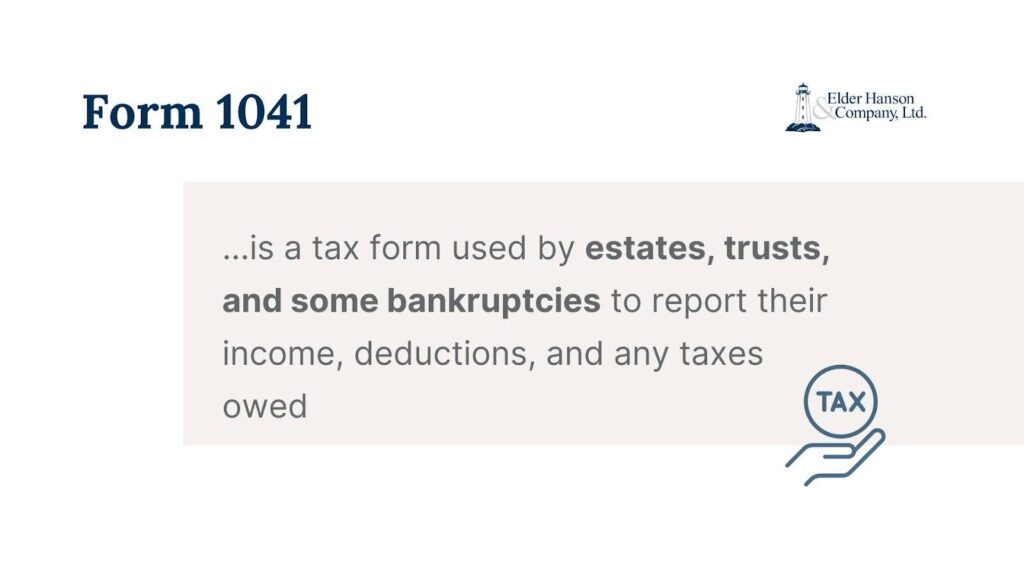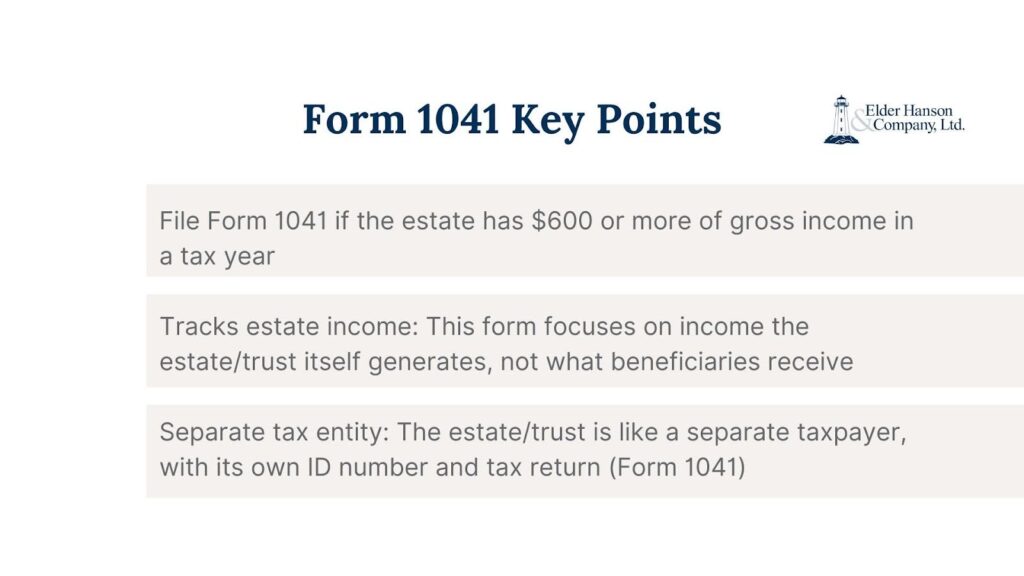What Is a 1041 Form? Understanding the U.S. Income Tax Return for Estates & Trusts
The passing of a loved one brings a multitude of emotions and practical considerations. Managing the financial affairs of an estate or trust isn’t easy, especially when it comes to navigating the complexities of tax returns. This article from our professional estate and trust tax CPAs in Naperville, IL, focuses on a crucial form in the estate and trust tax realm: Form 1041.
What Is Form 1041?

Form 1041, officially titled “U.S. Income Tax Return for Estates and Trusts,” serves a distinct purpose compared to your standard personal income tax return. It’s an IRS form used to report the income tax liability of an estate or trust. This includes income generated by the estate or trust after the decedent’s death and before the distribution of assets to beneficiaries. Essentially, it’s a separate tax return for the estate itself, distinct from the estate tax return (Form 706) which deals with the estate’s value at the time of death.
Key Points to Remember About Form 1041

1. Not Everyone Needs It
There is a filing threshold. Estates and trusts with an annual gross income below $600 generally don’t need to file Form 1041, unless there’s a nonresident alien beneficiary or it holds a qualified investment in a qualified opportunity fund (QOF) at any time during the year. The nonresident alien exception allows the IRS to track income distributed to beneficiaries who may live outside the U.S. and have different tax obligations.
2. Focus on Estate/Trust Income
This form reports income generated by the estate or trust itself, not the income of the beneficiaries. This can include interest earned on savings accounts, dividends from mutual funds, or rental income from properties owned by the estate. It’s important to distinguish this from the beneficiary’s share of the estate’s income, which is reported on a separate form (Schedule K-1) distributed to each beneficiary.
3. Separate Taxpayer
An estate or irrevocable trust is considered a separate taxable entity from the decedent and the beneficiaries. It has its own tax identification number (EIN, Employer Identification Number) and files its own tax return using Form 1041. Understanding this separate tax entity concept is crucial for ensuring proper tax reporting and avoiding confusion.
A Breakdown of Form 1041
Form 1041 might seem intimidating at first glance, but understanding its sections helps simplify the process. We’ve provided a breakdown of some key components.
1. Identifying Information
This section establishes who is filing the return – typically the personal representative of the estate (executor) or the trustee of the trust. The EIN for the estate or trust is also included here.
2. Income
This section details all the income categories reported on the form, including interest earnings, ordinary business income (e.g., rental income), capital gains (profits from asset sales), and any other income sources. Schedule D (Form 1041) is used to report capital gains, separating short-term and long-term gains for proper tax treatment.
3. Deductions
Similar to personal income tax returns, estates and trusts can claim various deductions to reduce their taxable income. Common deductions include estate administration expenses (e.g., legal and accounting fees), fiduciary fees paid to the executor or trustee, and the income distribution deduction (money distributed to beneficiaries). Schedule B is used to report most deductions claimed by the estate. It’s important to note that certain expenses incurred by the decedent, such as funeral expenses, aren’t deductible on Form 1041.
4. Tax and Payments
Based on the taxable income calculated after deductions, this section determines the estate or trust’s income tax liability. The form also includes sections for reporting any income taxes withheld and estimated tax payments made throughout the year. Depending on the complexity of the estate’s income and the tax bracket it falls under, the estate or trust may be subject to the alternative minimum tax (AMT), which is calculated on a separate schedule.
Need to File an Estate Income Tax Return Form in Naperville, IL?
Have your Form 1041/Form IL 1041 prepared by Certified Public Accountants and maximize your tax benefits.
Filing Form 1041
There are two primary ways to file Form 1041.
1. Electronically
The IRS encourages electronic filing for faster processing and fewer errors. At Elder Hanson & Company, Ltd., our default standard is to prepare estate and trust income tax returns to be electronically filed, which expedites the processing of the tax return and, when applicable, the receipt of a tax refund.
2. Mailing
You can mail the completed form (along with any required schedules) to the designated IRS address. The specific address depends on your location, but the IRS website provides instructions for finding the correct address.
The Due Date of 1041 and Considerations for Fiscal Years
The due date for filing Form 1041 is the 15th day of the 4th month following the close of the tax year. For calendar year filers this typically aligns with the individual income tax return filing deadline, which is usually April 15th of the following year. However, estates and certain trusts have some flexibility in this regard. Unlike individual taxpayers who are locked into the calendar year for tax purposes, estates and certain trusts can opt for a fiscal year instead. This means they can choose a different 12-month period based on the decedent’s month of death. When the fiscal year is selected, the first day of the month that the decent died is treated as the beginning date of the fiscal year, the fiscal year continues for 12 consecutive months (including the month the decent died) and ends on the last day of 12th month, which services as close of the fiscal tax year.
For example, if a decedent’s date of death is on June 10, 2024 and the estate elects to file using a fiscal tax year, then the fiscal year would span from June 2024 – May 2025. The due date of this Form 1041 estate income tax return would be September 15, 2025.
You can request a six-month extension for filing Form 1041 by using Form 7004. This extension applies only to the filing deadline, not the payment of any taxes owed.
Who Must File a 1041 Tax Return? (The Fiduciary’s Responsibility)
The responsibility to file Form 1041 falls on the fiduciary of the estate or trust, which is usually the executor or the trustee. As we touched on earlier, estates and trusts with minimal income (generally under $600 of gross income annually) are exempt from filing unless there is a nonresident alien beneficiary or it holds a qualified investment in a qualified opportunity fund (QOF) at any time during the year. Note that even if the estate or trust has no taxable income, there may still be a requirement to file Form 1041 to report the income distribution to beneficiaries. This ensures the IRS has a record of the distributed income and the beneficiaries can properly account for it on their personal tax returns.
Understanding Distributable Net Income
The income tax liability reported on Form 1041 is the responsibility of the estate or trust itself, not the beneficiaries. However, the concept of distributable net income (DNI) plays a crucial role in how the tax burden ultimately affects the beneficiaries. DNI essentially represents the amount of income from the estate or trust that can be distributed to beneficiaries without being taxed again at the estate or trust level. The income distribution deduction mentioned earlier factors into the calculation of DNI.
Beneficiaries then receive a Schedule K-1, which reports their share of the estate or trust’s income, deductions, and credits. This beneficiary’s share of the DNI is then reported on their personal tax return and may be subject to income taxes depending on their individual tax bracket.
What Is Form IL-1041?
The official document used to report the income tax liability of estates and trusts in the state of Illinois is Form IL-1041, the Illinois Fiduciary Income and Replacement Tax Return. Form IL-1041 is required for any estate or trust that has Illinois-sourced income or is considered a resident trust under state law. Similar to the federal Form 1041, Form IL-1041 captures details about the estate or trust’s income, deductions, and credits throughout the tax year.
The Importance of Professional Guidance for Estate and Trust Tax Matters
Navigating the intricacies of estate and trust tax returns, including Form 1041, can be a complex undertaking. While this article provides a basic overview, the specific tax implications for your situation can vary depending on the unique circumstances of your estate or trust. Factors such as the type of trust involved, the nature of the estate’s assets, and the income distribution plan for beneficiaries can all significantly impact the tax filing process.
At Elder Hanson & Company, Ltd., our experienced CPAs can provide comprehensive guidance on estate and trust tax matters. We can help you with:
- Determining whether you need to file Form 1041.
- Accurately completing Form 1041 and its associated schedules (including complex calculations like DNI).
- Minimizing the tax burden on your estate or trust by exploring tax-saving strategies.
- Identifying potential tax credits and deductions that may be applicable.
- Developing a tax-efficient plan for distributions to beneficiaries.
- Staying up-to-date on the latest changes in estate and trust tax laws.
By partnering with a qualified CPA, you can ensure your estate or trust adheres to IRS regulations while maximizing its after-tax benefits for your beneficiaries. Our company is passionate about serving you effectively and answering all of your questions along the way. Contact us today to schedule a consultation and discuss your specific needs in Naperville and beyond.
FAQ
What expenses are deductible on Form 1041?
Form 1041 deductions mirror those for individuals, with some exceptions. Common deductions include estate or trust administration fees, certain investment expenses, and specifically designated charitable contributions, all within IRS limitations.
Do beneficiaries file 1041?
Beneficiaries don’t file Form 1041. The estate or trust itself uses Form 1041 to report its income, deductions and credits. Beneficiaries receive a Schedule K-1 from the estate or trust, which details their share of income, deductions, and credits to report on their personal tax return (Form 1040).
What Is Form 1041-V?
Form 1041-V is a voucher that includes the estate or trust’s name, address, employer identification number (EIN), and the amount of the payment to be made to the IRS. It‘s a payment voucher that you submit alongside a check payment or money order for balances due to the IRS. It simplifies paying taxes owed on an estate or trust’s Form 1041.